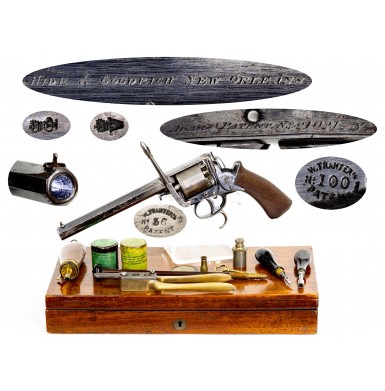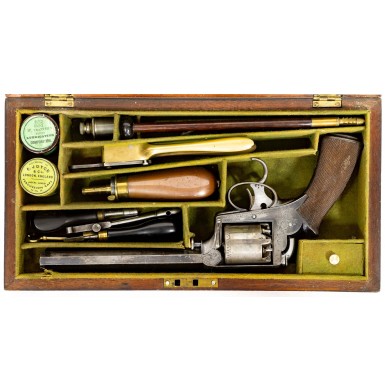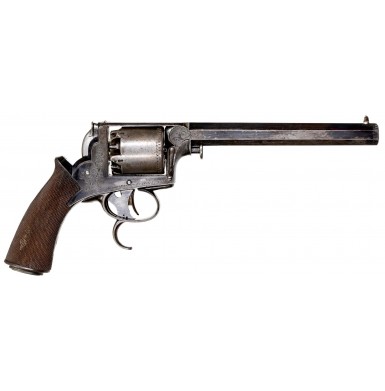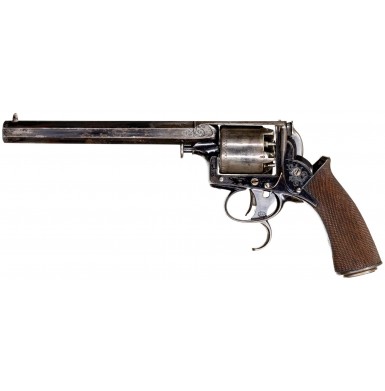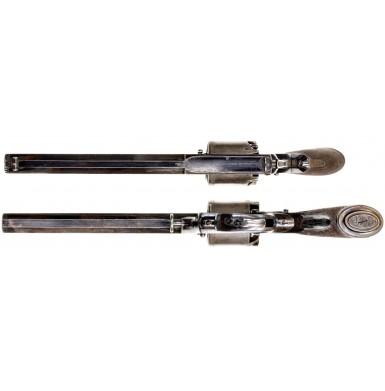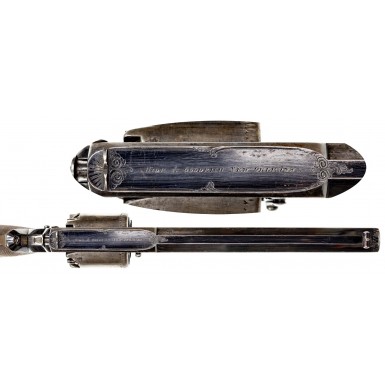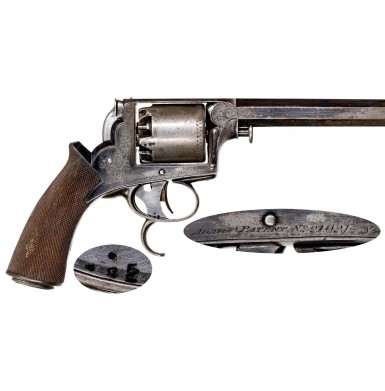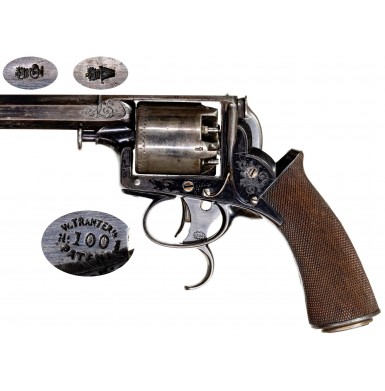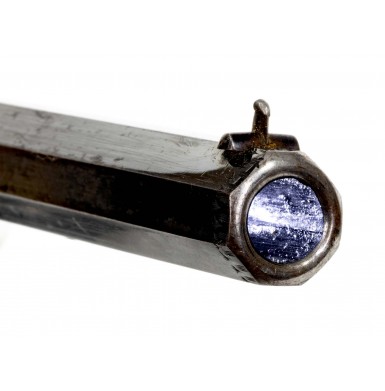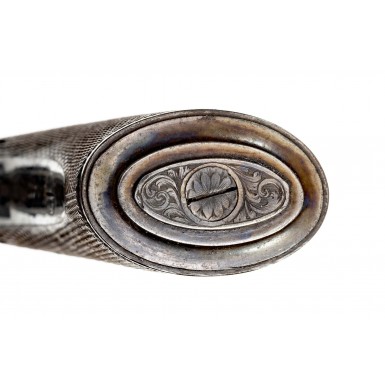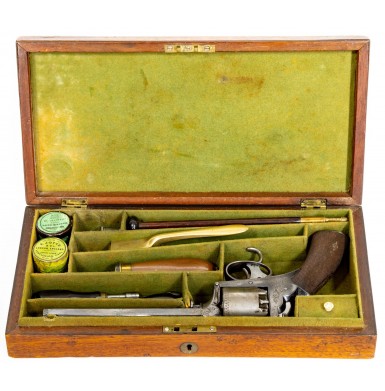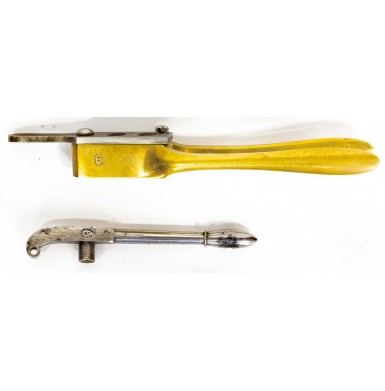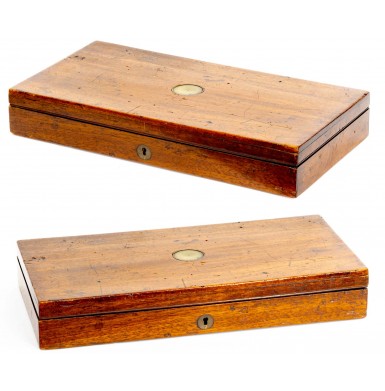Extremely Rare Published Cased Hyde & Goodrich 1st Model "Adams-Tranter" Dragoon Revolver in 36 Bore
- Product Code: FHG-2363-SOLD
- Availability: Out Of Stock
-
$1.00
The revolvers produced by English gunmaker William Tranter were some of the most advanced and modern handgun designs to see use by the Confederacy during the course of the American Civil War. Tranter was born in 1816 and died in 1890, and during his working life he was one of the most prominent Gun, Rifle & Pistol Makers in the Birmingham (England) gun trade. He went into business for himself circa 1840, after completing his apprenticeship with Hollis Brothers & Co, which he had begun in 1830. Tranter continued in the trade until 1885, just five years before his death.
In 1840, after spending a decade learning the gun trade at Hollis Bros & Co (later Hollis & Sheath), Tranter bought the established gun making business of Robert Dugard at 29 ½ Whitehall Street. Over the next decade he worked for himself and was also involved in joint ventures with his old employers John & Isaac Hollis as well as with Isaac Sheath. By 1850, he had located his primary business at 50 Loveday Street, where he was listed in a period directory as having “shops, sheds, steam machinery, yard & premises”. Tranter secured his first British patent related to firearms in October of 1849 when he registered a “pepperbox mechanism and lever catch for pistol locks”. In January 1853, he registered British Patent Number 212 (1853) for a pair of “self-cocking” pistol mechanisms and a safety mechanism. In December of the same year, he registered designs for a double-action revolver mechanism, lubricated bullets and wadding, and a breech loading mechanism, all of which were covered by Patent Number 2921 (1853). In August of 1856, he registered the designs for a “double trigger revolver mechanism”, along with several other designs, all of which were covered by British Patent Number 1913 (1856). Tranter continued patenting firearm designs as late as 1887, even though he was no longer directly active in the gun trade.
Tranter’s most successful series of arms were his “self-cocking” revolvers, which were initially introduced in 1853. The earliest revolvers utilized Robert Adams’ patent for a solid, one-piece frame and barrel that were machined from a single forging. Tranter’s initial production run of revolvers included both Adams 1851 Patent lock works, and Tranter's own patented lock works. The original “Tranter” type revolvers, known to collectors as 1st Model Tranter or sometimes “Adams-Tranter” revolvers due to the frame marking, had no provision for a fixed loading lever. The lever swiveled on a stud that projected from the left side of the frame, which had no provision to retain the lever when it was mounted on the revolver. The lever was intended to be stored in a case or carried in the pocket; hardly a practical solution if the user actually had to reload the revolver in the field. Most of these guns were manufactured on Adams Patent frames and have Adams Patent serial numbers, really patent tracking numbers to pay royalties to Adams, and these serial numbers are followed by a Y suffix.
The 2nd Model Tranter revolvers also had a pin on the frame that allowed the attachment of a removable loading lever, but the pin had a small projection that allowed the lever to remain attached to the gun unless a keyway notch in the lever was aligned with the stud projection to remove it. The later example of these guns, manufactured after about 1856, have Tranter Patent serial numbers and end with a T suffix. These guns not only include Tranter Patent lock works, but also a newly improved version of the Adams solid frame, which was patented by Tranter in 1856. At this point Tranter revolvers rarely have Adams serial numbers.
The 3rd Model Tranter revolvers had a more permanently attached loading lever, which was secured by a screw. The 3rdModels appear to have all been produced in the T suffix Tranter serial number range. All three of these models were based on his “double-trigger” system (initially referred to as his “hesitating mechanism” on the early production guns), which utilized a second “trigger” under the trigger guard to rotate the cylinder and cock the hammer. The trigger inside the triggerguard was used to trip the sear and release the hammer to fire the revolver. The 4th Model Tranter revolvers, which were introduced in 1856 and are all in the Tranter T-suffix series, used a single trigger. These guns utilized a lock work that would be referred to as a conventional “double action” mechanism today.
All of the Tranter revolver patterns were produced in a variety of calibers, with 54-Bore (.442) “Holster Size” and 120-Bore (.338) “Pocket Size” revolvers being the most commonly encountered calibers and frame sizes, and the mid-sized 80-Bore (.387) “Belt Size” being less often encountered. Some of the guns were also produced in the exceptionally large and powerful 36 and 38 bore sizes, which were larger versions of the holster size guns, and were about .50 caliber! Barrel lengths varied as well, with the larger caliber arms typically having longer barrels, and the smaller caliber guns having shorter barrel. All of the guns were 5-shot percussion revolvers, and typically featured checkered one-piece walnut grips, although smooth wooden grips and other grip materials are known to have been used on a special order basis.
The Tranter patent revolver was the primary competitor with the Adams and Beaumont-Adams patent revolvers in England and was also exported widely. Pre-Civil War Tranter revolvers are known with US retailer marks, indicating that his designs were at least somewhat successful in the United States. The majority of the retailer marked guns are from the southern states, with the largest majority of them being marked by New Orleans retailers. Based upon extant examples, the firm of Hyde & Goodrich (later Thomas, Griswold & Co) appears to have been the primary importer of Tranter Patent revolvers into the southern United States. Most of these retailer-marked guns were sold cased with accessories, although some guns were certainly sold without the expensive casings and accouterments. During the course of the American Civil War, it appears that the importation of Tranter revolvers was somewhat limited, at least in terms of Confederate central government purchases. However, period advertisements in the south and extant examples with southern provenance make it clear that the guns were imported by blockade-runners as speculative items for sale in the south. Such famous Confederates as General John Hunt Morgan (3rd Model #3758T), General J.E.B. Stuart (4th Model #8673T), General John Magruder and Colonel Dabney H. Maury (3rd Model #7993T), who served on the staff of General Earl Van Dorn, all owned documented 54-Bore Tranter revolvers. The famous “Pratt Roll”, which lists the revolvers in the possession of Lt. Julian Pratt’s squad of troopers in Company H of the 18th Virginia Cavalry in July of 1864, lists two Tranter revolvers, with the serial numbers 15,465 and 15,476. This indicates that Tranter revolvers in the mid 15,XXX serial number range were in use by southern forces, and in the field by that time. While models are not listed in the list, it is generally assumed that these guns were either 3rd of 4th model revolvers and were likely 54-Bore. Other Tranter revolvers with southern provenance include guns which are retailer marked by T.W. Radcliffe of Columbia, SC. Additionally, a March 10, 1863 advertisement in the Richmond Times Dispatch for H. E. Nichols of Columbia, SC read in part: “Fine English Revolvers. Just received from England, six Tranter’s fine revolving pistols, 80 and 120 bore. Price $220 each”.
All of this evidence indicates that at least some of the Tranter revolvers produced during (as well as prior to) the Civil War, saw Confederate use. Dating Tranter revolvers based upon their serial numbers is somewhat problematic, as frames were sometime produced in advance and the guns completed at a later date. What we do know is that the “T” serial number suffix came into use around serial number 2200, sometime between 1854 and 1856. We also know that Tranter produced revolvers using Adams' patent serial numbers and a “Y” suffix from about 1853 through about 1856. These guns appear in several serial number ranges, as assigned by Adams, including the 2X,XXX range. All “Y” suffix guns predate the Civil War by at least four or five years. From extant examples of Tranters with specific presentations, dated invoices and dates of usage associated with them, it appears that those Tranter revolvers with serial numbers through about the 20,XXX range (and possibly some of the early guns in the 21,XXX range) with T suffixes appear to have been produced prior to the end of 1865, making them “Civil War era”. Post-Civil War southern retailer marks begin to appear in the 21,XXX T range, suggesting that these guns are likely 1865 production, or possibly slightly later.
Offered here is a very scarce, early production cased 1st Model “Adams-Tranter” Dragoon Revolver retailer marked by Hyde & Goodrich of New Orleans in FINE condition. The revolver is in the very desirable, and rarely encountered 36-Bore, which is approximately .50 caliber. The 1st Model “Adams Tranter” revolvers were introduced in 1853 and remained in production through about 1856.
The over-sized revolver measures about 13” in overall length, with a 7 ½” octagonal barrel. The pistol is marked ADAMS’ PATENT No 21,021,Y on the lower right side of the frame. This is an Adams assigned serial number range, which started at 20,000, underscoring how early this revolver is in the production timeline. The cylinder is not engraved with the matching serial number, but is assembly numbered on the rear face 185, matching the assembly number visible on the right side of the trigger. The rear face of the cylinder is also stamped 36 for 36-Bore. The left side of the frame of the gun is not marked with the typical arced two-line Tranter cartouche that is commonly encountered on later production revolvers, as this was a reference to Tranter’s frame patent that he would receive in 1856 for an improved frame design. However, his patent mark is present on the left side of the trigger web and reads W. TRANTER’S / 1001/ PATENT in three lines, with the upper and lower lines forming an oval cartouche. I have owned another 1st Model Adams-Tranter that was #20468 Y with the trigger patent number 1066. This number is also a patent tracking number for royalty purposes, and it is worth noting that the gun #20468Y, theoretically produced 553 guns before this one, has a trigger mechanism numbered 65 after this one. This clearly shows how Tranter produced and numbered frames in quantity and then pulled the frames to produce guns, but not necessarily in consecutive order.
The revolver is retailer marked on the top strap and is engraved in a single line: HIDE & GOODRICH NEW ORLEANS. The most remarkable feature of the marking is that the name “Hyde” is misspelled as “Hide”. This brings to mind a couple of interesting fact. First, the retailer marking was clearly applied in England and the engraver, or possibly the Tranter company itself, did not know how to spell the name of Hyde. Secondly, the extremely low Y-suffix, Adams' patent serial number on the frame, roughly 1,000 numbers into the production of Tranter revolvers, combined with the misspelling of the retailer’s name, suggests that this may have been one of the very first Tranter’s imported by Hyde & Goodrich. The 1st Model “Adams Tranter” revolvers were introduced in 1853 and remained in production through about 1856. My best estimate is that this revolver was probably produced around 1854 and was certainly one of the earliest Tranter’s imported into the American south, by a firm that would be advertising that they were the primary importer and distributer of Tranter revolvers in America by the latter part of the 1850s. This interesting and important southern retailer marked Tranter revolver is pictured on page 237 of our book The English Connection – Arms, Material and Support Furnished to the Confederate States of America by Great Britain. This is probably the most intriguing Hyde & Goodrich mark to surface to date, with only the two line W. TRANTER’S PATENT / HYDE & GOODRICH. AGENTS FOR THE UNITED STATES SOUTH mark being nearly as interesting. This second mark appears in a portion of the T-suffix serial number range that suggests it was used during the first quarter of 1861 and interestingly the T-suffix Tranter’s in this serial number range of roughly 11,XXX to 12,XXX also appear with other southern retailer marks, like TW Radcliffe of Columbia, SC suggesting an increase in the importation of guns from England just before the American Civil War erupted.
Hyde & Goodrich was a partnership between James Nevins Hyde and his brother-in-law Charles Whiting Goodrich. The long time New Orleans based merchant, importer, retailer and jeweler had been established in 1819 at the corner of Canal & Royal streets in New Orleans. As a dealer in “fancy & military goods” they often sold arms and equipment to the local gentry who served in pre-war militia units like the famed Washington Artillery. As the clouds for sectional strife darkened and the likelihood of a Civil War increased, they apparently started to import more and more English-made firearms. The firm became Thomas, Griswold & Company in 1861 and produced and retailed a large number of edged weapons for the Confederacy until the fall of New Orleans in June of 1862. During that period the former Hyde & Goodrich supplied everything from naval cutlasses and cavalry sabers to high grade officer’s swords to the southern cause. By 1865 the firm was doing business under the new name A.B. Griswold & Co. Apparently, the fall of New Orleans to US forces in June of 1862 eventually caused the company to fail at least temporarily, but it soon rose from the ashes without Henry Thomas as one of the partners and continued with the name of Arthur Breese Griswold only. The company apparently was only out of business for a very short time, as in New Orleans & The New South author Andrew Morton sites a local New Orleans newspaper article from 1888 that says in part about the company: “AB Griswold & Co Retail and Manufacturing Jewelers of the corner of Canal and Royal streets is one of the oldest houses of the city. It was established in 1819 and is consequently now in its sixty ninth-year. Mr. Hyde its founder and Mr. Griswold, who was for many years in partnership with him, have long since passed away and the house has for many years been managed by Mr. Henry Ginder. A.B. Griswold & Co have traded all over the South. They have about twenty employees, among them expert jewelers, diamond setters and engravers. They occupy four floors of the corner of the old Touro buildings, in which, by the way, they were the first tenants and have numerous valuable agencies among them that for the Vacheron and Constantin watches. They are direct importers of clocks, bronzes, Geneva watches, etc. and they can repair the finest and most complicated works. In fine jewelry they have repeatedly distanced all rivals at competitions in the fairs of this and adjacent states.”
As noted above, the revolver is in about FINE condition. The gun shows some wear and use but still remains in fairly crisp condition with sharp edges and lines throughout. The gun retains about 35%+ of its original blued finish over all with most of the loss due to flaking and possibly due to holster wear. The frame retains slightly more of the blue than the barrel does, with much of blue on both portions remaining in protected areas. The metal is mostly smooth with some scattered surface oxidation and some scattered pinpricking. The areas where the finish has worn or flaked show a lightly oxidized gray and brown patina with flecks of more moderate surface oxidation here and there. The 7 ½” octagonal barrel bears the expected London commercial view and proof marks of {CROWN}/GP and a {CROWN}/V on the left angled flat near the front of the frame juncture. The cylinder is also marked with the usual London commercial proof and view marks, alternating between the chambers. The cylinder, like most early Tranter cylinders, is color casehardened and retains about 30%+ of that coloration, which has faded and thinned leaving more of a mottled pewter gray patina than anything approaching the vivid case colors that were present when the revolver was new. The cylinder retains all of its original cone (nipples), and they are all in fine, crisp condition with sharp edges and no significant battering or damage. The cylinder has light foliate themed boarder lines engraved around its front edge near the chamber mouths. The same pattern is found engraved around the muzzle of the revolver as well. The cylinder also shows scattered light surface oxidation and some lightly scattered pinpricking, with more moderate oxidation and some moderate pitting in the recesses around the cones. The frame, backstrap and buttcap are all neatly engraved with crisp English-style foliate themed patterns and scrolls. The bore of the revolver is in about FINE condition as well, with strong five-groove rifling. The bore is mostly bright but does show some moderate frosting and pinpricking along its length, along with some very lightly scattered pitting. The left side of the frame retains the original Tranter’s patent spring safety that prevents the hammer from contacting the cones unless the trigger is pulled. Using the safety also allows the cylinder to be turned freely for loading. The original arbor pin retaining spring catch is also present on the forward right side of the frame. Both the safety and the arbor catch are in perfect mechanical condition and both retain some dull traces of their original fire blued finish. The rear most screw securing the safety spring appears to be a modern replacement. The original, removable Tranter “1st Model” loading lever is included in the casing. It is not attached to the frame, as the 1st Model pivot stud on the frame does not have any facility to secure the lever. The lever in marked with the two-line TRANTER’S / PATENT cartouche around the number 36, indicating the plunger is sized for a 36-Bore ball. The lever freely slips on and off the stud and functions smoothly and correctly in place. The original front sight is dovetailed in place near the muzzle as well. The checkered walnut grip is in about FINE condition and matches the condition of the pistol very well. The grip is solid and free of any breaks, cracks or repairs. The checkering remains relatively sharp but does show some very light wear and minor flattening of the sharp end of the checkering. The action of pistol work very well and the revolver times, indexes and locks up, exactly as it should. As with all of the double-trigger Tranter percussion revolvers, the lock up is only accomplished when the lower trigger is pulled full to the rear in the “full cock” position. Otherwise, the cylinder is free to rotate when the safety is engaged.
The pistol is contained within its original mahogany veneered English retailer casing with no label. The casing is what I would call an “Adams Style” casing, rather than the “two hook” Tranter-style casing that becomes associated with the later production “T-suffix” Tranter revolvers. The compartmentalized case is lined in a medium olive green baize and contains a variety of accessories. The casing retains the original “Bible” hinges and a brass lock escutcheon on the front. The case is in about VERY GOOD condition and shows some moderate wear and finish loss on the exterior. As is often the case, the Bible hinges are sprung and will not support the lid in the correct 90-degree orientation when open. The brass lock escutcheon is present in the front of the case, and the lock has been repaired with a modern-made brass key that works the lock included. The interior compartments are lined with a faded and stained olive green baize that shows good age and moderate wear and appears to be absolutely original to the case. The case is in solid condition with no serious weakness to the exterior structure itself. The interior compartment dividers show moderate wear, as well as some weakness and looseness that should probably be addressed with some minor maintenance to prevent total separation of some of the dividers. One divider corner is cracked and needs some repair work to stabilize it, but the damage has been there since it was photographed for our book more than ten years ago.
The casing contains the following accessories for the revolver:
1) A FINE condition, correctly marked TRANTER’S / PATENT dual cavity brass bullet mold marked No 36 inside the two-line cartouche for 36-bore. The mold has two period lead bullets in the cavities, which are crisp and bright and retains much of the thinning blue on the sprue cutter.
2) A medium-sized bag-shaped copper Powder Flask in about VERY GOOD to NEAR FINE overall condition. The body of the flask shows scattered bumps, dings and mars. The polished brass top is clearly marked in three lines JAMES DIXON / & SONS / SHEFFIELD. The adjustable spout is marked for charges of 3/8, ½ and 5/8 Drams. The charging lever of the flask functions smoothly and correctly.
3) A FINE condition Pewter Oiler that is marked DIXON & SONS in a single line on the side.
4) A Cap Tin in VERY GOOD condition with paper F. JOYCE & CO labels on the body and the lid. The tin shows moderate wear and retains some caps inside, which cannot be shipped by any form of priority or air shipping service.
5) The detachable 1st Model Tranter Loading Lever in FINE condition.
Tags: Extremely, Rare, Published, Cased, Hyde, &, Goodrich, 1st, Model, Adams, Tranter, Dragoon, Revolver, in, 36, Bore

